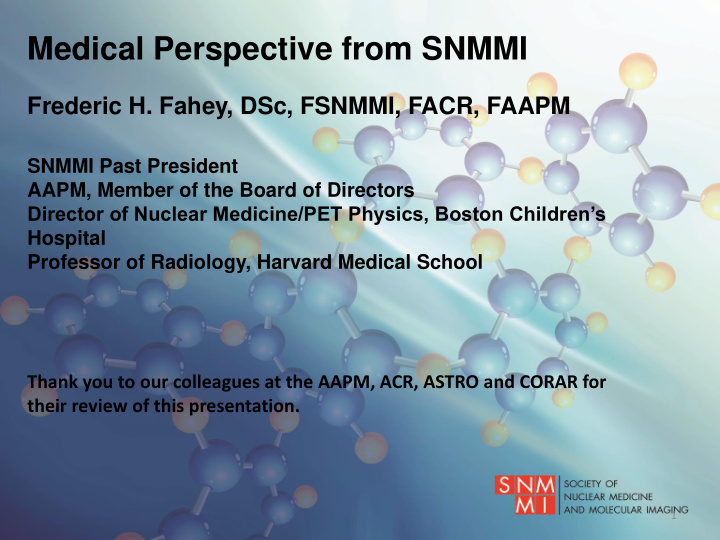



Medical Perspective from SNMMI Frederic H. Fahey, DSc, FSNMMI, FACR, FAAPM SNMMI Past President AAPM, Member of the Board of Directors Director of Nuclear Medicine/PET Physics, Boston Children’s Hospital Professor of Radiology, Harvard Medical School Thank you to our colleagues at the AAPM, ACR, ASTRO and CORAR for their review of this presentation. 1
Impact of Radioactive Materials on Patients What diseases or conditions can be diagnosed or treated with radioactive materials? • Cancer • Thyroid disorders • Cardiovascular disease • Gastrointestinal disorders • Neurological conditions • Lung disorders • Orthopedic disorders such as Alzheimer's • Renal disorders disease, Parkinson's disease and epilepsy Each year more than 18 million molecular imaging and nuclear medicine procedures are performed in the U.S. including myocardial perfusion studies and Positron Emission Tomography (PET). 114,200 patients are treated with radionuclide therapy each year in the U.S. for such conditions as thyroid disease and bone metastases from prostate cancer. Hopefully, this will soon be expanded to those suffering from neuroendocrine tumors and prostate cancer (IMV data, 2015). Approximately 81,000 patients are also treated with brachytherapy and 18,000 are treated with stereotactic radiosurgery (Gamma Knife) each year in the U.S. 2
NRC Impact on Patients • NRC regulations touch every aspect of the use of radionuclides in medicine including – Management and handling of radionuclides – Training requirements for physicians and other health professionals – Radiation protection of our patients and their families. • This is true for those in agreement states as well as NRC states • In addition, NRC’s occupational dose regulations and related policies on personal dosimetry can affect certain medical uses of x-rays not directly under NRC’s authority (i.e., fluoroscopy in interventional radiology) when implemented by the States 3
Inspections • Good communication between inspectors and licensees • NRC needs to ensure inspectors are knowledgeable with respect to the type of license being inspected • Creates opportunities to educate each other • Improve consistency and minimize variability of inspection process in communications • Minimize “surprises” • With new domestic Mo-99 producers on the horizon: – NRC should ensure that the current rules are applicable to these new facilities 4
Resolution of stakeholder comment/regulatory analysis • Medical use is distinct from energy use and should be regulated accordingly – Exciting time for nuclear medicine, molecular imaging and radiation oncology • New imaging agents recently approved by FDA (NETSPOT, Axumin, C-11 Choline) • Radionuclide therapies and “ theranostic ” agents soon available to patients enhance life, cure patients • Advances in brachytherapy and stereotactic radiosurgery • Delays in rulemaking can negatively impact patient care by limiting access to innovative technology – Part 35, more than a decade in its revision – Must seek ways to bring therapies to patients as quickly and safely as possible (e.g. moving new technologies out of 35.1000 rules for training into the appropriate subparts of Part 35) Bottom line for all parts: We want to provide our patients with the best technological advances possible that will allow us to treat their disease as effectively, efficiently and safely as possible. 5
Communication Between NRC and Medical Community Successes: • Eagerness to engage medical societies on pertinent issues • ACMUI engagement • Willingness to participate in our meetings and meet with stakeholders in the medical community • Supportive of risk-based approaches to rule making and inspections • Fast-tracking approvals for new devices and procedures ( 223 Ra Xofigo and 68 Ge/ 68 Ga generators) Opportunities for improvement: • Understanding the differences between medicine and other applications of radioactive materials • Overcoming a lack of understanding about how we practice in some instances • Delayed rule-making in the context of a rapidly growing field – Operational hurdles that hinder innovation and patient access – Negatively impact the potential domestic source of medical isotope (e.g. Mo-99) • Always room for better communication, e.g. with new medical isotope manufacturers – Transparency on development of fee schedule as it applies to various categories of 6 licensees
Contact Information Frederic H. Fahey, DSc, FSNMMI, FACR, FAAPM SNMMI Past President Director of Nuclear Medicine/PET Physics, Boston Children’s Hospital Professor of Radiology, Harvard Medical School frederic.fahey@childrens.harvard.edu 7
Recommend
More recommend